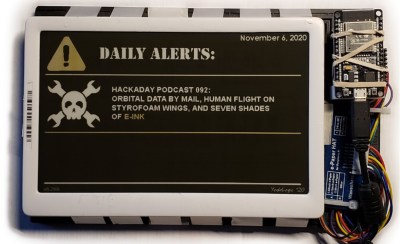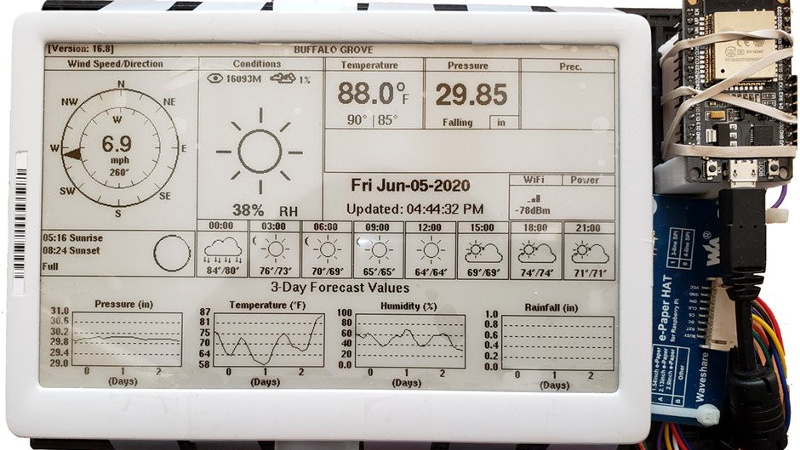If you’ve recently braved the pandemic long enough to make a trip to a big box retailer, you may have spotted a few massive e-paper price tags affixed to large items like appliances. These seven inch displays were likely designed to be used in e-readers such as the Kindle, but through some surplus deal, are now shouting out clearance savings on last year’s washing machine. After checking out a particularly good price for a Samsung refrigerator at the local Home Depot, [YodaLogic] got to wondering if they could be bent to the hacker’s will.
Now to be clear, [YodaLogic] didn’t steal any of these tags. It turns out you can pick them up on eBay for less than $15 a pop, or at least that’s what they cost before this article went out. It’s an exceptionally good price when you realize that these displays are actually capable of color…albeit only two. Apparently when the retailer orders the so-called “Chroma 74” tags, they can pick between either yellow or red as the secondary color. While not quite as exciting as a full-color display, it certainly sets them apart from most of the e-paper panels we’ve seen used in DIY projects thus far.

We’d like to tell you that [YodaLogic] cracked one of these things open and was able to wire it right up to a Pi or microcontroller, but the truth is a bit more complicated. Connecting the Chroma 74’s panel to the control board intended for a similar Waveshare 7.5 inch display didn’t seem to do anything. After some poking and prodding, it became clear that the WFD0750BF19 e-paper panel used in the Chroma needed a custom software profile to bring it to life. Unfortunately, there doesn’t seem to be a datasheet available for this particular panel.
By combining what could be gleaned from the datasheets of similar displays with a bit of experimentation, [YodaLogic] came up with a configuration profile that mostly works. It doesn’t seem like the yellow is as vibrant as it should be, and a refresh can take as long as 20 seconds, but it’s certainly a start. Perhaps the code can be tightened up with some input from the community, or even better, maybe somebody out there knows where we can get our hands on the datasheet for this panel.
While we’ve started to see more projects use e-paper displays, their high price still keeps many hackers away. Being able to repurpose cheap hardware like this could really spur some interesting development, so we’re excited to see [YodaLogic] put the finishing touches on this project and opened it up to a wider audience.
















I really enjoy seeing these e-paper or e-ink hacks. That’s the first thing I thought of when I was in Kohl’s and saw their digital price tags all around the store was how to hack them. There are many purposes for a slow-updating display. Anything where you need to monitor stats (like the pictured weather display) or display a picture would be great. I wonder if they update fast enough to be used as a glass panel on an ultralight aircraft. I suppose it depends how fast you intend to descend. If it’s really that fast, it won’t matter because you’d be dead anyway.
People modify the Barnes & noble Nook simple touch just for this purpose, with a otg gps
I got a-hold of a couple of those units from Kohls, but I have not had much luck with them. Unfortunately, you need the base station to wake them up, and mine had already been deactivated, so I was unable to scope the drive signals for the display; NO luck finding a data sheet either. They appear to use a custom COG LCD panel made by Powertip, with 240×128 resolution. The controller board is made by a company called Altierre, and uses what appears to be a custom ASIC for the RF and control functions on a very minimal board. They are powered by 8 2477 cells in parallel, and run on 3 volts. If anybody has any leads, any info about driving the display would be appreciated! Weather station was my planned application for the same reasons cited in this article.
E-ink as a Dashboard for the IoT in your life.
with partial refresh set up you can get a very good frame rate for small changes. So probably would be just find for ultralight. Though doing rapid updates does somewhat negate their big advantage of zero static power draw, could still be very worth it for the ultralight for the ease of reading in daylight.
Oops… now those panels are $47 on eBay…
The HaD effect. Any item mentioned on HaD will soon go up in price. :-p
Well I could order 48 from America for ~500€ (500$ + 45$ + ?€(customs tax)).
-> https://www.ebay.de/itm/133001695294
Tempting…
Well, I was gonna suggest some kind of teamwork (I’d take half and redistribute them over eBay or something along those lines) but now the auction is over…. :-/
I have 20 of those but don’t know how to activate. I would sell them for $20 each.
I would want one for my homebuilt AI assistant/Smart speaker
As it is now I have a 7″ touch LCD, but to be honest, it mostly shows static pictures, a clock, or the weather
An E ink display with some googly eyes slowly changing where they lookm or casually blinking/falling asleep would be a great inactive screen
These displays are pretty dang cool, and 7″ –> so many ideas. Question: Is using a display as a display really “repurposing”? It seems like hooking my TV to a Blueray player instead of cable. Anyway, why not contact Wuxi Vision Peak for info/datasheet?
Hard to tell if this is a serious comment or not…
This comment is not serious.
I’d say it’s a repurpose. The device is meant to be a price tag; now it’s a weather station display. A TV is meant to be multipurpose, this isn’t.
Plus, if hooking your TV to your Blu-Ray player took reverse-engineering and firmware chops, it would be a lot more interesting to read about!
I get it. Kind of like a piece of paper. You could take a price tag, turn it over and use a pencil to repurpose it as a name tag. You change its use case but it still does exoinformation.
Or maybe more like a sheet of thermal paper. Coated with ptfe it’s nearly useless with a pen or pencil but if you cobble together a controlable heat element…
Would be interesting to use to display APRS information.
It’s one of the things this would be perfect for since APRS doesn’t really
need updating every picosecond.
This might be the Mandela effect, but isn’t this a re-upload? I feel like I’ve seen this article (complete with the joke about the pricing going up after it goes out) befor.
Ok. At least I’m not the only one who thought that
Lol I’m glad I’m not crazy!